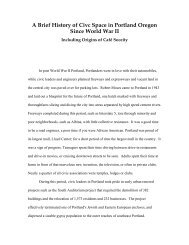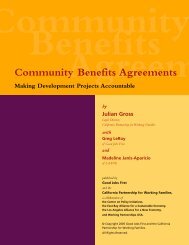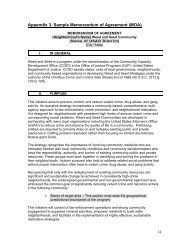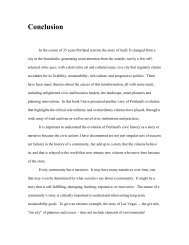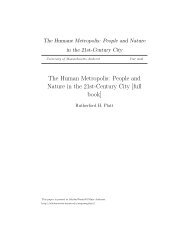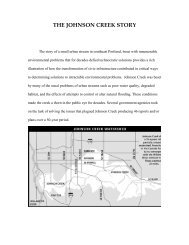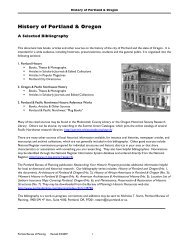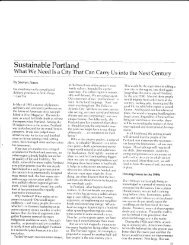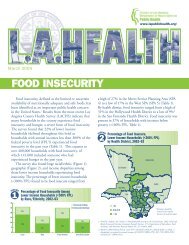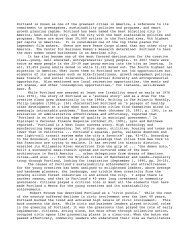Social Equity Mapping, Matrix of Indicators - Steven Reed Johnson
Social Equity Mapping, Matrix of Indicators - Steven Reed Johnson
Social Equity Mapping, Matrix of Indicators - Steven Reed Johnson
Create successful ePaper yourself
Turn your PDF publications into a flip-book with our unique Google optimized e-Paper software.
Regional Opportunity <strong>Mapping</strong>/ <strong>Equity</strong> Atlas Project<br />
Final Indicator List by Priority Tier as <strong>of</strong> 3/1/12<br />
Issue Indicator Measurements Priority Tier Map Type<br />
Education<br />
Teacher<br />
qualifications<br />
Class size<br />
Teacher experience<br />
Class size<br />
2 Point<br />
2 Points<br />
School success<br />
rate<br />
Course <strong>of</strong>ferings<br />
Schools meeting/ not meeting<br />
Adequate Yearly Progress<br />
(AYP)<br />
Availability <strong>of</strong> Advanced<br />
Placement and International<br />
Baccalaureate courses<br />
2 Points<br />
3 (only use map if<br />
the data shows a<br />
meaningful<br />
pattern once<br />
mapped<br />
Points<br />
School discipline<br />
Disparities in school discipline<br />
3 Points<br />
Early childhood<br />
education<br />
Racial/ ethnic<br />
composition <strong>of</strong><br />
school<br />
Language diversity<br />
<strong>of</strong> school<br />
Arts education<br />
Proximity to<br />
school<br />
Locations <strong>of</strong> Head Start and<br />
licensed child care centers<br />
Race <strong>of</strong> students<br />
Languages spoken at home by<br />
students<br />
Availability <strong>of</strong> art, music,<br />
theater and/or dance classes<br />
Walking distance to nearest<br />
elementary school<br />
2 Points<br />
1 Points<br />
1 Points<br />
2 Points<br />
1 Raster -<br />
proximity<br />
Outcome:<br />
Test scores<br />
Outcome:<br />
Graduation rates<br />
Outcome: Postsecondary<br />
enrollment<br />
Schools meting/ not meeting<br />
state benchmarks for test<br />
scores<br />
Graduation rates by cohort<br />
Percent <strong>of</strong> graduates who<br />
enroll in higher education<br />
1 Points<br />
1 Points<br />
3 (or 0 if data not<br />
available)<br />
Points<br />
Tiers: 1= Highest; 2= Medium; 3- Lowest; 0= Delete
Issue Indicator Measurements Priority Tier Map Type<br />
Economic Availability <strong>of</strong> Density <strong>of</strong> jobs appropriate for<br />
1 (if data can be Raster -<br />
Opportunity accessible jobs workers with associate’s degree<br />
or below 1<br />
fixed)<br />
density<br />
Availability <strong>of</strong><br />
living wage jobs<br />
Transportation to<br />
jobs<br />
Industrial lands<br />
for development<br />
Workforce<br />
training<br />
Commuting and<br />
job location<br />
patterns<br />
Small business<br />
Educational<br />
attainment<br />
Outcome:<br />
Employment rate<br />
Density <strong>of</strong> living wage jobs<br />
appropriate for workers with<br />
associate’s degree or below<br />
Number <strong>of</strong> jobs accessible to<br />
households within<br />
Transportation Analysis Zones<br />
Inventory <strong>of</strong> large industrial<br />
tracts available for development<br />
Location <strong>of</strong> workforce training<br />
and employment-related services<br />
Where do the employees <strong>of</strong> local<br />
employers live? Where do<br />
neighborhood residents work?<br />
Location/ growth <strong>of</strong> small<br />
businesses (ideally by type,<br />
demographics <strong>of</strong> owners)<br />
Levels <strong>of</strong> adult educational<br />
attainment<br />
Employment rate<br />
1 (if data can be<br />
fixed)<br />
2 (trial to see if it<br />
works with<br />
Context Tool)<br />
Choropleth by<br />
zip code or<br />
neighborhood<br />
Depends on<br />
format <strong>of</strong><br />
modeled data<br />
– Clint will<br />
experiment<br />
3 Points or<br />
polygon<br />
2 Points<br />
2 (if data can be<br />
fixed)<br />
0 (Unless OMEN<br />
provides data)<br />
Needs further<br />
work<br />
Needs further<br />
work<br />
1 Choropleth by<br />
Census Tract<br />
1 Choropleth by<br />
Census Tract<br />
1 The original formulation <strong>of</strong> this indicator was jobs within 5 miles, but Clint will play with the distance measurements to find something<br />
that results in a meaningful map. The distance will be based on as the crow flies.<br />
Tiers: 1= Highest; 2= Medium; 3- Lowest; 0= Delete
Issue Indicator Measurements Priority Tier Map Type<br />
Housing Housing affordability Distribution <strong>of</strong> owner occupied and<br />
1 To be<br />
rental housing by cost<br />
determined<br />
Change in<br />
affordability over<br />
time<br />
Housing cost burden<br />
Publicly-subsidized<br />
housing<br />
Fair housing<br />
Accessible housing<br />
Rental vs. ownership<br />
rates<br />
Utility costs<br />
Outcome:<br />
Ownership gap<br />
Outcome:<br />
Housing +<br />
transportation<br />
Outcome:<br />
Foreclosures<br />
Outcome:<br />
homelessness<br />
Change in housing costs over time<br />
Share <strong>of</strong> renters and owners<br />
spending over 30% <strong>of</strong> income on<br />
housing<br />
Location <strong>of</strong> publicly subsidized<br />
housing units and Section 8, coded<br />
for target population<br />
Loan denials by race and income<br />
Single story housing (as a proxy for<br />
housing accessible to seniors and<br />
those with disabilities)<br />
Percentage <strong>of</strong> renter households<br />
Household utility costs<br />
Minority homeownership gap<br />
Housing + transportation cost<br />
burden<br />
Foreclosure rate or foreclosure risk<br />
score<br />
Sheltered and unsheltered<br />
homeless<br />
1 To be<br />
determined<br />
1 Choropleth by<br />
Census Tract<br />
1 Points<br />
Section 8 as<br />
choropleth by<br />
zip code<br />
1 Choropleth by<br />
Census Tract<br />
2 Raster -<br />
density<br />
1 Raster -<br />
density<br />
2 To be<br />
determined<br />
1 Raster -<br />
density<br />
1 Choropleth by<br />
Housing<br />
Needs<br />
Analysis Areas<br />
2 Choropleth<br />
(geography to<br />
be<br />
determined)<br />
3 (if data will<br />
permit<br />
geographic<br />
mapping)<br />
To be<br />
determined<br />
Tiers: 1= Highest; 2= Medium; 3- Lowest; 0= Delete
Issue Indicator Measurements Priority Tier Map Type<br />
Healthy<br />
Environment<br />
Air quality<br />
Proximity to sources <strong>of</strong> air pollution<br />
and concentrations <strong>of</strong> air toxics<br />
1 Raster –<br />
proximity<br />
and density<br />
(varies by<br />
specific data<br />
layer)<br />
Compromised<br />
environments<br />
Green<br />
infrastructure<br />
Water quality<br />
Vacant land<br />
Proximity to toxic waste, brownfield,<br />
and superfund sites<br />
Density <strong>of</strong> tree canopy, natural<br />
habitat, parks, and other sources <strong>of</strong><br />
neighborhood “greening”<br />
Rivers, flood plains, streams, etc.<br />
coded by habitat health and subwatershed<br />
health<br />
Vacant and undeveloped land<br />
(Note: This indicator should be been<br />
moved to the reference layer list<br />
because it is more appropriate there)<br />
1 Points<br />
1 Raster -<br />
density<br />
3 Points and<br />
lines<br />
2 Polygon<br />
Tiers: 1= Highest; 2= Medium; 3- Lowest; 0= Delete
Issue Indicator Measurements Priority Tier Map Type<br />
Parks and<br />
Natural<br />
Areas<br />
Publicly accessible<br />
parks<br />
Publicly accessible<br />
natural areas<br />
Regional trails<br />
Recreation<br />
facilities<br />
Greenspaces with<br />
limited public<br />
access<br />
Publicly accessible<br />
regional parks<br />
Greenspace<br />
quality<br />
Water access<br />
points<br />
Walking distance to publicly<br />
accessible parks<br />
Walking distance to publicly<br />
accessible natural areas<br />
Walking distance to walking trails<br />
1 Raster -<br />
proximity<br />
1 Raster -<br />
proximity<br />
2 Raster -<br />
proximity<br />
Walking distance to community<br />
2 Raster -<br />
centers, pools, tennis courts, and<br />
sports fields 2 proximity<br />
Walking distance to school grounds,<br />
golf courses, cemeteries, HOAS<br />
3 Raster -<br />
proximity<br />
Proximity to regional parks 3 1 Raster –<br />
proximity<br />
Level <strong>of</strong> greenspace development<br />
and presence <strong>of</strong> usable and<br />
accessible recreation space<br />
Proximity to water access point<br />
(e.g. boat or canoe launch)<br />
3 (data will need<br />
to be collected –<br />
this will probably<br />
need to be<br />
added down the<br />
road)<br />
Raster --<br />
proximity<br />
2 Points<br />
2 If it is not possible to separate out sports fields from the “Fairgrounds, fields, and stadium” layer in RLIS, then include fairgrounds and<br />
stadiums<br />
3 The reason for listing these separately from other parks is that stakeholders suggested using a different distance measurement than<br />
“walkability” for these larger regional parks. Clint can decide whether this makes sense from a mapping perspective and what the<br />
distance should be.<br />
Tiers: 1= Highest; 2= Medium; 3- Lowest; 0= Delete
Issue Indicator Measurements Priority Tier Map Type<br />
Food<br />
Proximity to food<br />
stores<br />
Proximity to supermarkets and grocery<br />
stores<br />
1 Raster -<br />
proximity<br />
Proximity to fresh<br />
food<br />
Proximity to farmer’s markets,<br />
produce stands, and produce markets<br />
1 Raster -<br />
proximity<br />
Subsidized food<br />
Community<br />
gardens<br />
Supplemental<br />
nutrition<br />
Unhealthy food<br />
Proximity to food stores and farmers’<br />
markets that accept food stamps<br />
(SNAP) and WIC<br />
Locations <strong>of</strong> community garden sites<br />
Locations <strong>of</strong> supplemental nutrition<br />
programs such as food pantries, soup<br />
kitchens, and congregate meal sites<br />
Proximity to liquor stores,<br />
convenience stores, and fast food<br />
restaurants<br />
3 Raster -<br />
proximity<br />
2 Points<br />
1 Points<br />
1 Raster -<br />
proximity<br />
Tiers: 1= Highest; 2= Medium; 3- Lowest; 0= Delete
Issue Indicator Measurements Priority Tier Map Type<br />
Transportation<br />
Public transit<br />
access<br />
Public transit stop<br />
safety and quality<br />
Walkability<br />
Density <strong>of</strong> transit within ¼ mile,<br />
measuring transit by both<br />
frequency and trip options<br />
Transit stop safety and quality<br />
Density <strong>of</strong> sidewalks within ¼ mile<br />
<strong>of</strong> a location<br />
1 Raster -<br />
density<br />
2 Points<br />
1 Raster -<br />
density<br />
Bikability<br />
Density <strong>of</strong> bike routes within one<br />
mile <strong>of</strong> a designated area<br />
1 Raster -<br />
density<br />
Transportation<br />
safety<br />
Mobility access<br />
Crash data analyzed separately for<br />
cars, bikes, and pedestrians by<br />
seriousness <strong>of</strong> crash<br />
Para-transit lift requests and fixedroute<br />
ramp deployments<br />
3 To be<br />
determined<br />
2 Raster –<br />
density<br />
Car access<br />
Outcome:<br />
Transportation<br />
costs<br />
Outcome:<br />
Commute patterns<br />
% <strong>of</strong> households without access to<br />
a vehicle<br />
% income spent on transportation<br />
Average commute time and mode<br />
<strong>of</strong> transit<br />
3 Choropleth –<br />
Census Tract<br />
1 Choropleth –<br />
Census Tract<br />
1 Choropleth –<br />
Census Tract<br />
Tiers: 1= Highest; 2= Medium; 3- Lowest; 0= Delete
Issue Indicator Measurements Priority Tier Map Type<br />
Public services Locations <strong>of</strong> libraries, fire stations,<br />
1 Points<br />
Services and<br />
and other public services in RLIS and<br />
ESRI<br />
Amenities<br />
Human and social<br />
services<br />
Retail services<br />
Financial services<br />
Sub-prime financial<br />
services<br />
Arts<br />
Locations <strong>of</strong> homeless services,<br />
senior services, services for people<br />
with disabilities, and veterans’<br />
services<br />
Density <strong>of</strong> key retail services (based<br />
on Healthy Development<br />
Measurement Tool Neighborhood<br />
Retail Index)<br />
Locations <strong>of</strong> banks, financial<br />
institutions, and credit unions<br />
Locations <strong>of</strong> pay day loan and checkcashing<br />
businesses<br />
Locations <strong>of</strong> formal arts and culture<br />
institutions and public art<br />
1 Points<br />
1 Raster -<br />
density<br />
1 Points<br />
3 (or 0<br />
depending on<br />
data availability)<br />
Points<br />
3 Points<br />
Tiers: 1= Highest; 2= Medium; 3- Lowest; 0= Delete
Issue Indicator Measurement Priority Tier Map Type<br />
Health Availability <strong>of</strong> medical Density <strong>of</strong> hospitals, primary care<br />
2 Raster -<br />
Care care<br />
physicians, dentists, and urgent care<br />
density<br />
Availability <strong>of</strong><br />
affordable health care<br />
Accessibility <strong>of</strong><br />
subsidized care<br />
Availability <strong>of</strong><br />
affordable mental<br />
health care<br />
Availability <strong>of</strong><br />
affordable dental care<br />
Availability <strong>of</strong> alcohol<br />
and drug treatment<br />
Access to preventive<br />
care<br />
Lack <strong>of</strong> preventive<br />
care<br />
Lack <strong>of</strong> access to<br />
health care<br />
Access to health<br />
insurance<br />
Locations <strong>of</strong> community, public, and<br />
school-based health clinics for<br />
uninsured or low-income patients<br />
Density <strong>of</strong> health care providers that<br />
accept Medicaid and/or Medicare<br />
Locations <strong>of</strong> mental health services for<br />
uninsured or low-income patients<br />
Locations <strong>of</strong> dental care services for<br />
uninsured or low-income patients<br />
Locations <strong>of</strong> alcohol and drug<br />
treatment<br />
Rate <strong>of</strong> well-child visits<br />
Use <strong>of</strong> ER for preventable problems<br />
Use <strong>of</strong> ER by uninsured patients<br />
(mapped by patient address)<br />
1 Points<br />
1 Raster -<br />
density<br />
2 Points<br />
2 Points<br />
3 Points<br />
3 Choropleth –<br />
Census Tract<br />
3 Choropleth –<br />
Census Tract<br />
3 To be<br />
determined<br />
% <strong>of</strong> population with health insurance 2 Choropleth –<br />
Census Tract<br />
Tiers: 1= Highest; 2= Medium; 3- Lowest; 0= Delete
Issue Indicator Measurements Priority Tier Map Type<br />
Geographic<br />
Proximity to seat <strong>of</strong><br />
accessibility <strong>of</strong><br />
government, City Hall, etc.<br />
1 Points<br />
decision-making<br />
Democratic<br />
Participation<br />
Outcome:<br />
Voter registration<br />
Outcome:<br />
Voter participation<br />
Voter registration rates<br />
Voter participation rates<br />
2 To be<br />
determined<br />
2 To be<br />
determined<br />
Tiers: 1= Highest; 2= Medium; 3- Lowest; 0= Delete
Issue Indicator Potential measurements Priority Tier Map Type<br />
Safety and Crime rates, homicide deaths,<br />
1 To be<br />
Community security<br />
and/or calls to 911<br />
determined<br />
Community<br />
spaces<br />
Civic<br />
organizations<br />
Faith-based<br />
institutions<br />
Stability<br />
Stability<br />
Community centers, schools,<br />
granges, and other indoor<br />
gathering places<br />
Density <strong>of</strong> civic and community<br />
organizations<br />
Density <strong>of</strong> faith-based<br />
institutions<br />
% <strong>of</strong> vacant houses<br />
Length <strong>of</strong> time people have lived<br />
in their homes<br />
2 Points<br />
3 or 0 (depends<br />
on data<br />
availability)<br />
Raster -<br />
density<br />
2 Raster -<br />
density<br />
2 Raster -<br />
density<br />
1 Choropleth –<br />
Census Tract<br />
Tiers: 1= Highest; 2= Medium; 3- Lowest; 0= Delete
Issue Indicator Potential measurements Priority Tier Map Type<br />
Demographic Population Density <strong>of</strong> residents in each<br />
1 Raster -<br />
and<br />
density<br />
neighborhood<br />
density<br />
Population<br />
Change in Above indicator with changes<br />
<strong>Indicators</strong> population from 1990-2000-2010<br />
3 Chorpoleth?<br />
density over<br />
time<br />
Residential +<br />
employee<br />
density<br />
Income<br />
Change in<br />
income over<br />
time<br />
Student poverty<br />
Change in<br />
student poverty<br />
over time<br />
Density <strong>of</strong> residents and<br />
employees in each neighborhood<br />
Median income; % <strong>of</strong> population<br />
in poverty<br />
Above indicator with changes<br />
from 1990-2000-2010<br />
% <strong>of</strong> students eligible for free and<br />
reduced lunch by school<br />
Above indicator with changes<br />
from 1990-2000-2010<br />
2 Raster -<br />
density<br />
1 Choropleth –<br />
Census Tract<br />
3 Choropleth –<br />
Census Tract<br />
1 Points<br />
3 Points<br />
Race/ ethnicity • Maps for each Census race<br />
category 4<br />
1 Raster –<br />
density or<br />
• A composite map <strong>of</strong><br />
Populations <strong>of</strong> Color 5 Choropleth –<br />
Census Tract<br />
(?)<br />
Change in race<br />
over time<br />
Above indicator with changes<br />
from 1990-2000-2010<br />
Age Maps for 0-5, 5-17, 18-44, 45-64,<br />
65+<br />
Change in age<br />
over time<br />
Household type<br />
Disabilities<br />
Change in<br />
disabilities over<br />
time<br />
Above indicator with changes<br />
from 1990-2000-2010<br />
Families, single adults, single<br />
parent families, intergenerational<br />
households, etc.<br />
% with disabilities, broken out by<br />
type<br />
Above indicator with changes<br />
from 1990-2000-2010<br />
3 Choropleth –<br />
Census Tract<br />
1 Raster –<br />
density or<br />
Choropleth –<br />
Census Tract<br />
(?)<br />
3 Choropleth –<br />
Census Tract<br />
2 Raster –<br />
density or<br />
Choropleth –<br />
Census Tract?<br />
2 Choropleth –<br />
Census Tract<br />
3 Choropleth –<br />
Census Tract<br />
4 Hispanic/ Latino will be treated as a race. Respondents who identified multiple races should be included in each map for each race<br />
they identified.<br />
5 Populations <strong>of</strong> Color would include all Census respondents except those identifying as White non-Hispanics.<br />
Tiers: 1= Highest; 2= Medium; 3- Lowest; 0= Delete
Non-English<br />
speakers<br />
Change in non-<br />
English speakers<br />
over time<br />
Immigrants<br />
Change in<br />
immigrants over<br />
time<br />
Low English pr<strong>of</strong>iciency<br />
households<br />
Above indicator with changes<br />
from 1990-2000-2010<br />
% foreign born; % recent<br />
immigrants<br />
Above indicator with changes<br />
from 1990-2000-2010<br />
1 Choropleth –<br />
Census Tract<br />
3 Choropleth –<br />
Census Tract<br />
1 Choropleth –<br />
Census Tract<br />
3 Choropleth –<br />
Census Tract<br />
Veterans % veterans 2 Choropleth –<br />
Census Tract<br />
Change in<br />
veterans over<br />
time<br />
Above indicator with changes<br />
from 1990-2000-2010<br />
3 Choropleth –<br />
Census Tract<br />
Tiers: 1= Highest; 2= Medium; 3- Lowest; 0= Delete
Issue Indicator Potential measurements Priority Tier Map Type<br />
Obesity Rates % adults qualifying as obese<br />
based on Body Mass Index<br />
Health<br />
Outcomes<br />
Asthma Rates<br />
Diabetes Rates<br />
Cardiovascular<br />
Disease Rates<br />
Birth Outcomes<br />
Mortality Rate<br />
Life Expectancy<br />
Child asthma rates<br />
Adult asthma rates<br />
Adult diabetes rates (type II)<br />
Cardiovascular disease rates<br />
(2013)<br />
Deaths from cardiovascular<br />
disease (2012)<br />
Infant mortality, pre-term births,<br />
low birth weight<br />
Age-adjusted mortality rate<br />
(possibly broken out by major<br />
categories <strong>of</strong> cause <strong>of</strong> death)<br />
Life expectancy<br />
1 Choropleth –<br />
Census Tract?<br />
(available by<br />
block group,<br />
but wait to<br />
match format<br />
with other<br />
data in this<br />
category)<br />
1 To be<br />
determined<br />
1 To be<br />
determined<br />
1 To be<br />
determined<br />
1 To be<br />
determined<br />
2 To be<br />
determined<br />
1 To be<br />
determined<br />
Tiers: 1= Highest; 2= Medium; 3- Lowest; 0= Delete
Reference Layers<br />
• Race<br />
• Income<br />
• Age<br />
• Population density<br />
• Transportation: street grid and transit<br />
• Schools: school districts, schools as points, school catchment areas (if available in RLIS)<br />
• Natural resources: watersheds, streams, rivers, wetlands<br />
• Vacant land (from RLIS vacant land layer)<br />
• Neighborhood boundaries<br />
• City boundaries<br />
• County boundaries<br />
• Political and land use boundaries: legislative districts, service districts, UGBs, urban renewal areas, zoning<br />
• Aerial photos<br />
Analysis Geographies<br />
• Census tracts<br />
• Neighborhoods<br />
• Cities<br />
• Counties<br />
• Population-based geographies – to be determined; will likely include:<br />
Above regional average populations <strong>of</strong> color<br />
Above regional average populations over age 65<br />
Above regional average populations under age 18<br />
Above regional average populations in poverty<br />
Tiers: 1= Highest; 2= Medium; 3- Lowest; 0= Delete



